Xueqi Ma
CLR-Wire: Towards Continuous Latent Representations for 3D Curve Wireframe Generation
May 01, 2025Abstract:We introduce CLR-Wire, a novel framework for 3D curve-based wireframe generation that integrates geometry and topology into a unified Continuous Latent Representation. Unlike conventional methods that decouple vertices, edges, and faces, CLR-Wire encodes curves as Neural Parametric Curves along with their topological connectivity into a continuous and fixed-length latent space using an attention-driven variational autoencoder (VAE). This unified approach facilitates joint learning and generation of both geometry and topology. To generate wireframes, we employ a flow matching model to progressively map Gaussian noise to these latents, which are subsequently decoded into complete 3D wireframes. Our method provides fine-grained modeling of complex shapes and irregular topologies, and supports both unconditional generation and generation conditioned on point cloud or image inputs. Experimental results demonstrate that, compared with state-of-the-art generative approaches, our method achieves substantial improvements in accuracy, novelty, and diversity, offering an efficient and comprehensive solution for CAD design, geometric reconstruction, and 3D content creation.
GenUDC: High Quality 3D Mesh Generation with Unsigned Dual Contouring Representation
Oct 23, 2024Abstract:Generating high-quality meshes with complex structures and realistic surfaces is the primary goal of 3D generative models. Existing methods typically employ sequence data or deformable tetrahedral grids for mesh generation. However, sequence-based methods have difficulty producing complex structures with many faces due to memory limits. The deformable tetrahedral grid-based method MeshDiffusion fails to recover realistic surfaces due to the inherent ambiguity in deformable grids. We propose the GenUDC framework to address these challenges by leveraging the Unsigned Dual Contouring (UDC) as the mesh representation. UDC discretizes a mesh in a regular grid and divides it into the face and vertex parts, recovering both complex structures and fine details. As a result, the one-to-one mapping between UDC and mesh resolves the ambiguity problem. In addition, GenUDC adopts a two-stage, coarse-to-fine generative process for 3D mesh generation. It first generates the face part as a rough shape and then the vertex part to craft a detailed shape. Extensive evaluations demonstrate the superiority of UDC as a mesh representation and the favorable performance of GenUDC in mesh generation. The code and trained models are available at https://github.com/TrepangCat/GenUDC.
Generating 3D House Wireframes with Semantics
Jul 17, 2024Abstract:We present a new approach for generating 3D house wireframes with semantic enrichment using an autoregressive model. Unlike conventional generative models that independently process vertices, edges, and faces, our approach employs a unified wire-based representation for improved coherence in learning 3D wireframe structures. By re-ordering wire sequences based on semantic meanings, we facilitate seamless semantic integration during sequence generation. Our two-phase technique merges a graph-based autoencoder with a transformer-based decoder to learn latent geometric tokens and generate semantic-aware wireframes. Through iterative prediction and decoding during inference, our model produces detailed wireframes that can be easily segmented into distinct components, such as walls, roofs, and rooms, reflecting the semantic essence of the shape. Empirical results on a comprehensive house dataset validate the superior accuracy, novelty, and semantic fidelity of our model compared to existing generative models. More results and details can be found on https://vcc.tech/research/2024/3DWire.
Dual-perspective Cross Contrastive Learning in Graph Transformers
Jun 01, 2024Abstract:Graph contrastive learning (GCL) is a popular method for leaning graph representations by maximizing the consistency of features across augmented views. Traditional GCL methods utilize single-perspective i.e. data or model-perspective) augmentation to generate positive samples, restraining the diversity of positive samples. In addition, these positive samples may be unreliable due to uncontrollable augmentation strategies that potentially alter the semantic information. To address these challenges, this paper proposed a innovative framework termed dual-perspective cross graph contrastive learning (DC-GCL), which incorporates three modifications designed to enhance positive sample diversity and reliability: 1) We propose dual-perspective augmentation strategy that provide the model with more diverse training data, enabling the model effective learning of feature consistency across different views. 2) From the data perspective, we slightly perturb the original graphs using controllable data augmentation, effectively preserving their semantic information. 3) From the model perspective, we enhance the encoder by utilizing more powerful graph transformers instead of graph neural networks. Based on the model's architecture, we propose three pruning-based strategies to slightly perturb the encoder, providing more reliable positive samples. These modifications collectively form the DC-GCL's foundation and provide more diverse and reliable training inputs, offering significant improvements over traditional GCL methods. Extensive experiments on various benchmarks demonstrate that DC-GCL consistently outperforms different baselines on various datasets and tasks.
Hi-GMAE: Hierarchical Graph Masked Autoencoders
May 17, 2024Abstract:Graph Masked Autoencoders (GMAEs) have emerged as a notable self-supervised learning approach for graph-structured data. Existing GMAE models primarily focus on reconstructing node-level information, categorizing them as single-scale GMAEs. This methodology, while effective in certain contexts, tends to overlook the complex hierarchical structures inherent in many real-world graphs. For instance, molecular graphs exhibit a clear hierarchical organization in the form of the atoms-functional groups-molecules structure. Hence, the inability of single-scale GMAE models to incorporate these hierarchical relationships often leads to their inadequate capture of crucial high-level graph information, resulting in a noticeable decline in performance. To address this limitation, we propose Hierarchical Graph Masked AutoEncoders (Hi-GMAE), a novel multi-scale GMAE framework designed to handle the hierarchical structures within graphs. First, Hi-GMAE constructs a multi-scale graph hierarchy through graph pooling, enabling the exploration of graph structures across different granularity levels. To ensure masking uniformity of subgraphs across these scales, we propose a novel coarse-to-fine strategy that initiates masking at the coarsest scale and progressively back-projects the mask to the finer scales. Furthermore, we integrate a gradual recovery strategy with the masking process to mitigate the learning challenges posed by completely masked subgraphs. Diverging from the standard graph neural network (GNN) used in GMAE models, Hi-GMAE modifies its encoder and decoder into hierarchical structures. This entails using GNN at the finer scales for detailed local graph analysis and employing a graph transformer at coarser scales to capture global information. Our experiments on 15 graph datasets consistently demonstrate that Hi-GMAE outperforms 17 state-of-the-art self-supervised competitors.
Where to Mask: Structure-Guided Masking for Graph Masked Autoencoders
Apr 24, 2024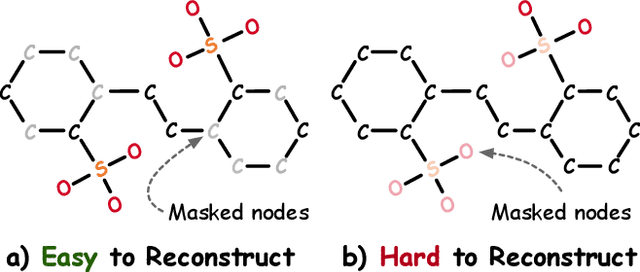
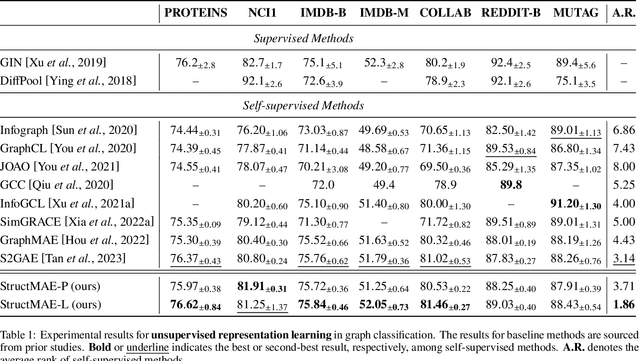

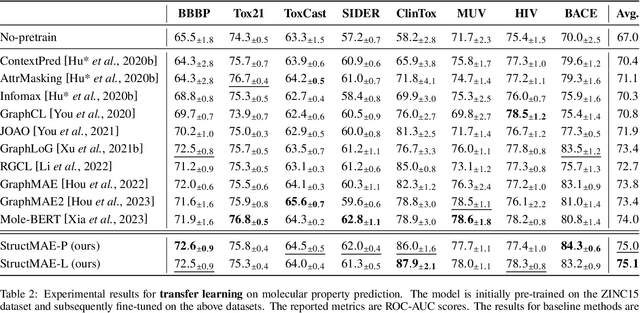
Abstract:Graph masked autoencoders (GMAE) have emerged as a significant advancement in self-supervised pre-training for graph-structured data. Previous GMAE models primarily utilize a straightforward random masking strategy for nodes or edges during training. However, this strategy fails to consider the varying significance of different nodes within the graph structure. In this paper, we investigate the potential of leveraging the graph's structural composition as a fundamental and unique prior in the masked pre-training process. To this end, we introduce a novel structure-guided masking strategy (i.e., StructMAE), designed to refine the existing GMAE models. StructMAE involves two steps: 1) Structure-based Scoring: Each node is evaluated and assigned a score reflecting its structural significance. Two distinct types of scoring manners are proposed: predefined and learnable scoring. 2) Structure-guided Masking: With the obtained assessment scores, we develop an easy-to-hard masking strategy that gradually increases the structural awareness of the self-supervised reconstruction task. Specifically, the strategy begins with random masking and progresses to masking structure-informative nodes based on the assessment scores. This design gradually and effectively guides the model in learning graph structural information. Furthermore, extensive experiments consistently demonstrate that our StructMAE method outperforms existing state-of-the-art GMAE models in both unsupervised and transfer learning tasks. Codes are available at https://github.com/LiuChuang0059/StructMAE.
Gradformer: Graph Transformer with Exponential Decay
Apr 24, 2024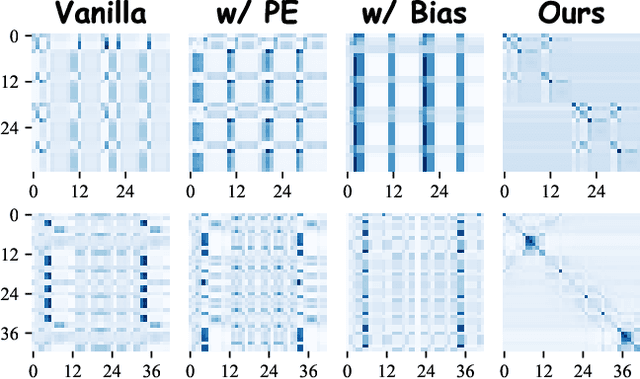
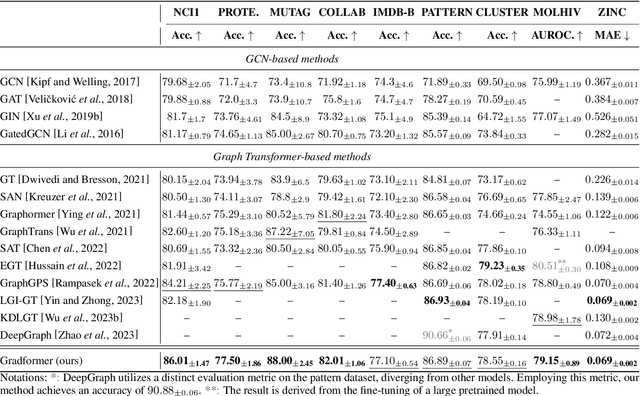
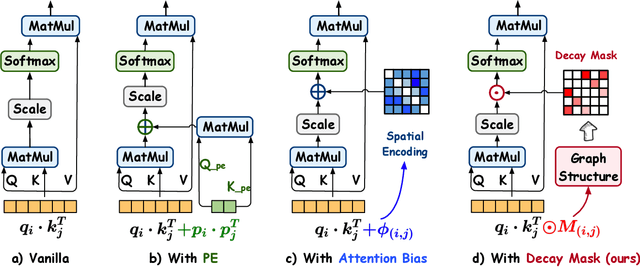
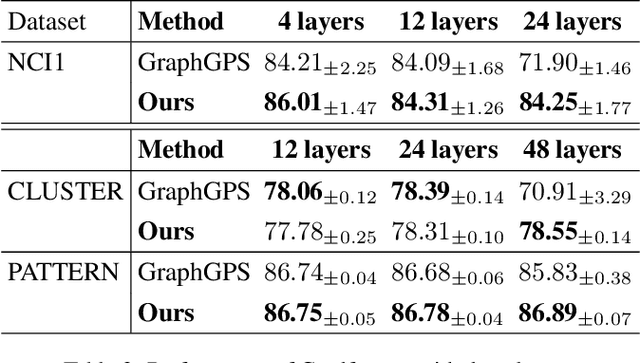
Abstract:Graph Transformers (GTs) have demonstrated their advantages across a wide range of tasks. However, the self-attention mechanism in GTs overlooks the graph's inductive biases, particularly biases related to structure, which are crucial for the graph tasks. Although some methods utilize positional encoding and attention bias to model inductive biases, their effectiveness is still suboptimal analytically. Therefore, this paper presents Gradformer, a method innovatively integrating GT with the intrinsic inductive bias by applying an exponential decay mask to the attention matrix. Specifically, the values in the decay mask matrix diminish exponentially, correlating with the decreasing node proximities within the graph structure. This design enables Gradformer to retain its ability to capture information from distant nodes while focusing on the graph's local details. Furthermore, Gradformer introduces a learnable constraint into the decay mask, allowing different attention heads to learn distinct decay masks. Such an design diversifies the attention heads, enabling a more effective assimilation of diverse structural information within the graph. Extensive experiments on various benchmarks demonstrate that Gradformer consistently outperforms the Graph Neural Network and GT baseline models in various graph classification and regression tasks. Additionally, Gradformer has proven to be an effective method for training deep GT models, maintaining or even enhancing accuracy compared to shallow models as the network deepens, in contrast to the significant accuracy drop observed in other GT models.Codes are available at \url{https://github.com/LiuChuang0059/Gradformer}.
Exploring Sparsity in Graph Transformers
Dec 09, 2023
Abstract:Graph Transformers (GTs) have achieved impressive results on various graph-related tasks. However, the huge computational cost of GTs hinders their deployment and application, especially in resource-constrained environments. Therefore, in this paper, we explore the feasibility of sparsifying GTs, a significant yet under-explored topic. We first discuss the redundancy of GTs based on the characteristics of existing GT models, and then propose a comprehensive \textbf{G}raph \textbf{T}ransformer \textbf{SP}arsification (GTSP) framework that helps to reduce the computational complexity of GTs from four dimensions: the input graph data, attention heads, model layers, and model weights. Specifically, GTSP designs differentiable masks for each individual compressible component, enabling effective end-to-end pruning. We examine our GTSP through extensive experiments on prominent GTs, including GraphTrans, Graphormer, and GraphGPS. The experimental results substantiate that GTSP effectively cuts computational costs, accompanied by only marginal decreases in accuracy or, in some cases, even improvements. For instance, GTSP yields a reduction of 30\% in Floating Point Operations while contributing to a 1.8\% increase in Area Under the Curve accuracy on OGBG-HIV dataset. Furthermore, we provide several insights on the characteristics of attention heads and the behavior of attention mechanisms, all of which have immense potential to inspire future research endeavors in this domain.
Careful Selection and Thoughtful Discarding: Graph Explicit Pooling Utilizing Discarded Nodes
Nov 21, 2023



Abstract:Graph pooling has been increasingly recognized as crucial for Graph Neural Networks (GNNs) to facilitate hierarchical graph representation learning. Existing graph pooling methods commonly consist of two stages: selecting top-ranked nodes and discarding the remaining to construct coarsened graph representations. However, this paper highlights two key issues with these methods: 1) The process of selecting nodes to discard frequently employs additional Graph Convolutional Networks or Multilayer Perceptrons, lacking a thorough evaluation of each node's impact on the final graph representation and subsequent prediction tasks. 2) Current graph pooling methods tend to directly discard the noise segment (dropped) of the graph without accounting for the latent information contained within these elements. To address the first issue, we introduce a novel Graph Explicit Pooling (GrePool) method, which selects nodes by explicitly leveraging the relationships between the nodes and final representation vectors crucial for classification. The second issue is addressed using an extended version of GrePool (i.e., GrePool+), which applies a uniform loss on the discarded nodes. This addition is designed to augment the training process and improve classification accuracy. Furthermore, we conduct comprehensive experiments across 12 widely used datasets to validate our proposed method's effectiveness, including the Open Graph Benchmark datasets. Our experimental results uniformly demonstrate that GrePool outperforms 14 baseline methods for most datasets. Likewise, implementing GrePool+ enhances GrePool's performance without incurring additional computational costs.
Comprehensive Graph Gradual Pruning for Sparse Training in Graph Neural Networks
Jul 19, 2022



Abstract:Graph Neural Networks (GNNs) tend to suffer from high computation costs due to the exponentially increasing scale of graph data and the number of model parameters, which restricts their utility in practical applications. To this end, some recent works focus on sparsifying GNNs with the lottery ticket hypothesis (LTH) to reduce inference costs while maintaining performance levels. However, the LTH-based methods suffer from two major drawbacks: 1) they require exhaustive and iterative training of dense models, resulting in an extremely large training computation cost, and 2) they only trim graph structures and model parameters but ignore the node feature dimension, where significant redundancy exists. To overcome the above limitations, we propose a comprehensive graph gradual pruning framework termed CGP. This is achieved by designing a during-training graph pruning paradigm to dynamically prune GNNs within one training process. Unlike LTH-based methods, the proposed CGP approach requires no re-training, which significantly reduces the computation costs. Furthermore, we design a co-sparsifying strategy to comprehensively trim all three core elements of GNNs: graph structures, node features, and model parameters. Meanwhile, aiming at refining the pruning operation, we introduce a regrowth process into our CGP framework, in order to re-establish the pruned but important connections. The proposed CGP is evaluated by using a node classification task across 6 GNN architectures, including shallow models (GCN and GAT), shallow-but-deep-propagation models (SGC and APPNP), and deep models (GCNII and ResGCN), on a total of 14 real-world graph datasets, including large-scale graph datasets from the challenging Open Graph Benchmark. Experiments reveal that our proposed strategy greatly improves both training and inference efficiency while matching or even exceeding the accuracy of existing methods.
 Add to Chrome
Add to Chrome Add to Firefox
Add to Firefox Add to Edge
Add to Edge